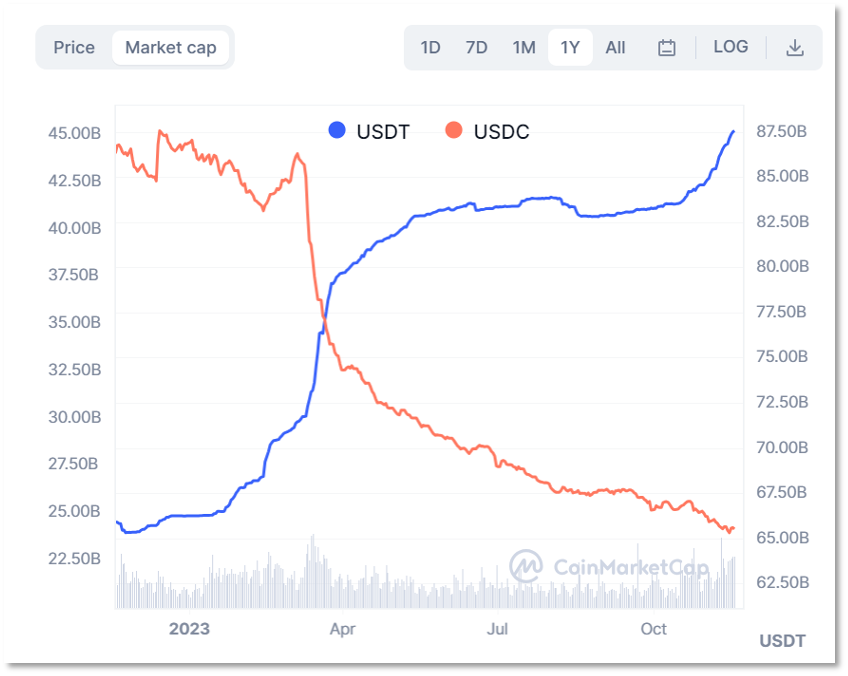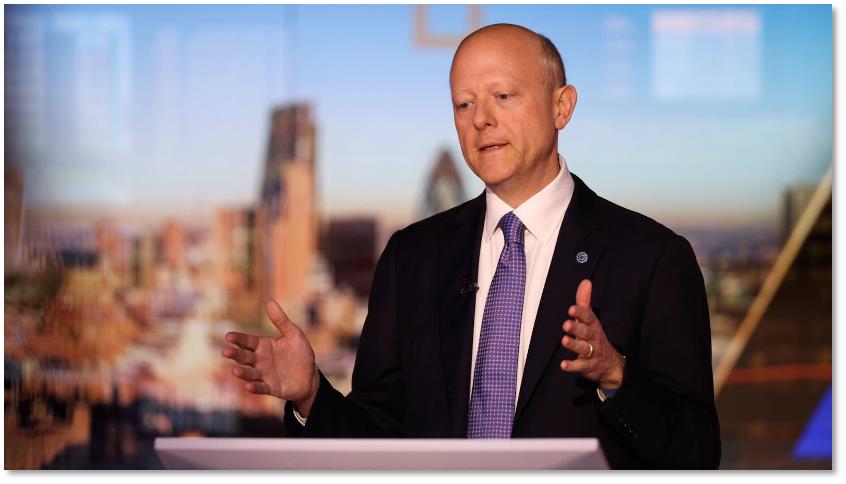USDC is "broken" by USDT, why is Circle pushing for an IPO again?
Author: Weilin, Hive Tech
Since its launch, the dollar stablecoin "compliance representative" USDC has begun to compete with the "originator" USDT, focusing on market share. Since the second half of this year, the decline of USDC has become increasingly apparent.
As of November, the circulating market value of USDC was $24.42 billion, while USDT stood at $87.72 billion, with the latter's market size being more than three times that of the former.
In 2018, USDC's issuer Circle hoped to capture the market with its compliance advantages, and at one point, the two dollar stablecoins were neck and neck in circulation on the Ethereum network.
An unexpected turn occurred in March of this year when Silicon Valley Bank, which held USDC reserves, declared bankruptcy. In an instant, Circle not only found itself stuck with over $3 billion in funds but also faced a $2 billion redemption of USDC, which temporarily caused USDC to decouple from the dollar.
The trouble is that market competition is intensifying, with even traditional payment giant PayPal entering the fray by issuing PYUSD. The dollar stablecoin market is gradually entering a phase of stock competition, and Bloomberg has reported that Circle plans to go public in 2024. Is another crypto asset company seeking survival through traditional capital operations?
USDC's Circulating Market Value Less Than 1/3 of USDT
In the dollar stablecoin market, the market sizes of USDC and USDT have always been in a state of ebb and flow. However, since the second half of 2023, USDC's circulating market value has sharply declined, while USDT has surged.
In January of this year, USDC's circulating market value was $44.5 billion, but by November, it had dropped to $24.42 billion, while USDT's circulating market value grew from $66.24 billion in January to $87.72 billion in November, more than 3.5 times that of USDC.
As of November 27, the total circulating market value of all dollar stablecoins was $127.55 billion, with USDT accounting for 68.7%, USDC for 19.1%, and the remaining approximately 12% held by other dollar stablecoins such as DAI (decentralized stablecoin), TUSD, and BUSD.
In the crypto asset market, dollar stablecoins are undoubtedly the "hardest of hard currencies." If you consider Bitcoin (BTC) and Ethereum (ETH) as the "goods" of the crypto asset world, then dollar stablecoins are the "money" used to purchase these goods.
This concept of a special asset theoretically pegged to the dollar at a 1:1 ratio has been serving as an intermediary for the exchange of various crypto assets since it was created by the "originator" Tether.
Initially, the market was 100% dominated by USDT created by Tether. It wasn't until 2018 that Circle issued USDC, focusing on compliance and ensuring that USDC's issuance was backed by dollars or cash equivalents in an auditable manner, thereby maintaining the parity of 1 USDC to 1 dollar.
The emergence of USDC not only broke USDT's monopoly but also objectively pressured Tether to be more transparent about its reserves. In January 2021, USDC's circulation on the Ethereum network briefly surpassed that of USDT, and Circle was seen as Tether's most formidable competitor.
However, entering 2023, USDT regained the upper hand, leaving USDC far behind with a market value advantage of 3.5 times. According to CoinMarketCap, the turning point occurred in March of this year when USDC faced its biggest crisis since its launch.

Since March, USDC's market share has been on a continuous decline.
On March 10 of this year, Silicon Valley Bank (SVB) announced its closure after a bank run. This 16th largest commercial bank in the U.S. suffered losses due to investing in long-term U.S. Treasury bonds during the Federal Reserve's interest rate hikes, leading to a downgrade in its credit rating and ultimately bankruptcy amid ongoing customer withdrawals.
Unfortunately, Silicon Valley Bank was one of the banks holding Circle's cash reserves. On the same day the bank announced its closure, Circle stated that Silicon Valley Bank managed about 25% of USDC's cash reserves, with approximately $3.3 billion still held at the bank out of a total of $40 billion in USDC reserves.
In a panic, the demand for USDC to be redeemed for dollars surged, with over $2 billion worth of USDC exiting the dollar stablecoin market. In the short-term run on the bank, USDC decoupled from the dollar, with its price plummeting to around $0.87.
Since then, USDC's market share has not recovered from its downward trend. Although its circulating market value still ranks second in the dollar stablecoin market, compared to USDT, it feels like "going back to square one."
What’s worse, payment giant PayPal has also entered the market. In August of this year, PayPal announced the launch of the dollar stablecoin PYUSD. As of now, PYUSD's circulating market value is $158 million. Although small in size, the compliant stablecoin PYUSD is backed by PayPal's 400 million users and has vast potential in cross-border payment scenarios.
With competition from both inside and outside Web3, how will Circle maintain its market position?
On November 8, Bloomberg reported new information from informed sources: Circle is in talks with advisors to consider an IPO in 2024, with discussions ongoing.
The familiar question arises again: is a company profiting from the crypto asset market now seeking a lifeline from traditional capital markets? This time, the answer may lie in the alignment of Old Money and New Money.
Why is Circle Pushing for an IPO Again?
In August of this year, Circle's CEO Jeremy Allaire disclosed Circle's revenue data during an interview with Bloomberg, revealing that Circle's revenue for the first half of this year was $779 million, surpassing the full-year revenue of $772 million in 2022; the profit for the first half was $219 million, also exceeding the full-year profit of $150 million in 2022.
Allaire used data to demonstrate Circle's profitability, clearly aiming to build momentum for the IPO. But if Circle's ability to generate revenue is so strong, why is there an urgency to go public?
The CEO has made it clear: making Circle a publicly traded company is one of the core strategies to enhance trust and transparency.
Compared to capital operations, an IPO for Circle is more like a strong endorsement of credit, especially after experiencing the run on the bank crisis in March, which directly put Circle at a disadvantage in the scale competition with Tether.

Circle CEO Jeremy Allaire
Although stablecoins are the "hard currency" of the crypto asset world, their circulation is always related to the overall demand in the market. Theoretically, when the prices of crypto assets like BTC and ETH rise, the market's willingness to hold stablecoins decreases, leading to reduced demand; conversely, when crypto asset prices fluctuate downward, the market tends to hold stablecoins, which are more stable in price.
This means that only with a continuous increase in the market value of crypto assets will the demand for stablecoins increase, and the market size of stablecoins will expand. Unless stablecoins can find more useful application scenarios than the crypto asset market.
Therefore, in a limited demand environment, no matter how many competitors there are for stablecoins, they can only find ways to carve out a position in the existing market.
Circle has clearly made an effort, but has lost out in the competition with the absolute leader Tether.
With the reality of not being able to compete with Tether in the crypto asset market and now facing the strong presence of PayPal in traditional finance, Circle must continue to explore the potential of Web3 finance while highlighting its compliance. An IPO is a powerful path that can allow Circle to reach capital and clients that were previously inaccessible, including more mainstream financial investors and institutions.
So far, Circle has secured multiple rounds of venture capital, with investors including Goldman Sachs, General Catalyst Partners, BlackRock, Fidelity Investments, and Marshall Wace. According to Axios, Circle's valuation reached $7.7 billion in 2022.
As the crypto asset market remains in a bear market, venture capital firms have slowed their investments in crypto companies at later stages, and Circle is among these companies. From a capital operations perspective, going public is also a better choice for Circle.
In fact, as early as July 2021, Circle had considered an IPO, planning to merge with a blank check company through a special purpose acquisition company (SPAC) to go public on the New York Stock Exchange. Later, with the rapid growth of USDC's market share, Circle's valuation once reached $9 billion, making it an opportune time for an IPO, and many preparations were made for it.
At that time, CEO Allaire positioned Circle on Twitter as "the most open and transparent fully reserved stablecoin operator in today's market."
He stated that not only would all of Circle's financial accounts meet the highest accountability standards, but all of this publicly disclosed information would ultimately comply with the standards of the top U.S. financial regulatory agency, the SEC. "As Circle grows, it bears greater expectations and demands for greater transparency, and Circle intends to be a leader throughout this process."
However, Circle's path to going public was blocked by the SEC. In December 2022, Circle disclosed that the permission document for the issuance of new shares (S-4 registration) related to the merger agreement between the two companies was not approved as "effective" by the SEC. Circle's IPO journey was thus halted.
Entering 2023, Circle began to strengthen its cooperation with traditional financial companies, including financial management company BNY Mellon, financial data company Plaid, and banks and payment companies like Signature Bank, Visa, and Mastercard.
As a crypto asset service provider, Circle also welcomed an investment from U.S. crypto exchange Coinbase in August of this year. Coinbase is also a publicly traded company and was one of the first compliant trading platforms to introduce USDC, laying the foundation for USDC's early expansion in the stablecoin market.
Additionally, new issuance plans for USDC will be launched across six new blockchain networks, with DeFi ecosystems on these chains helping to increase demand for USDC. The latest news indicates that in November of this year, the Layer 1 blockchain newcomer Sei Network received strategic investment from Circle and plans to integrate USDC into the growing applications on the Sei chain.
After suffering a significant setback from the bankruptcy of Silicon Valley Bank, Circle has chosen to walk on two legs—Web3 finance + traditional finance—while the IPO is one of the "muscles" supporting this strategy.
As of now, it remains uncertain how much valuation Circle will seek in its IPO. If Bloomberg's report is accurate, the upcoming 2024 will provide the final answer.









